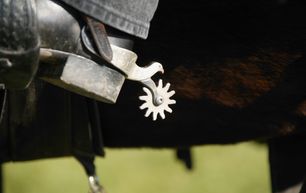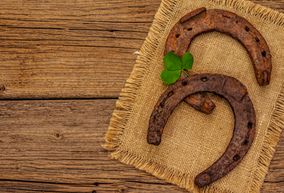vaccinations:
The Clydesdale.dk recommends that the horses are vaccinated and that the vaccinations are maintained annually.
In order for the horse to be able to participate in national competitions under the Danish Riding Association, the horse must be basic vaccinated twice a minimum of 21 days and 92 days apart. Then you must be vaccinated again at the earliest 5 months and at the latest 6 months and 21 days. After the third vaccination, there must be another 7 days before the horse must start the event. When the horse is basic vaccinated, it should only be maintained once a year
Hoof care:
One of the daily routines with Clydesdale horses is the maintenance and supervision of the hoofs. Healthy hoofes are all crucial to your well-being. It is therefore important that proper pruning of the horse is performed. Some horse owners crop traditionally, but many choose to let Clydesdale horses get "wings" on the hoofs. The wings make the horse get a bigger hoof and thus a smaller pressure per cm2.
Missing or wrong cropping can be fatal to the horse's quality of life, and for the foal and the young, it may significantly reduce the sales value.
The hygiene in the stable is important for the health of the hoof. Use a lot of suction, and be sure to remove all the wet daily. Spray with a powdered disinfectant once or twice a week. Also, at the bottom of the box, when completely cleaned.
Whether hooving is to be done daily, there are many opinions about. If the horse is cropped correctly in the suits, dirt should fall out when the horse moves. If the horse has access to a dry rent or is being taken to the stable, it is normally not necessary to clean the hoofs every day.
But if the hoofs are constantly moist and do not get rid of soil and dirt they should be cleaned daily.
How the crop is done should be agreed with the farrier - as well as the daily maintenance should also be in consultation with the farrier.
Care of feathering
Horses with feathering often have the mites and cupboards in the legs. The feathering protects the horse from attack, and it is a big mistake to remove it.
Once you have acquired a Clydesdale, you have also taken on the task to fit the feathering.
Traditionally, Clydesdale horses in Scotland have been treated and maintained with paraffinized mineral oil (Shireoil)
The oil is available either as pure oil or with various additives - eg sulfur.
If the horse has no problems with mites or mold, lubricate the legs one to two times a week with pure Shireoil. The oil lays itself like a cane around each hair, and massage it well into the leg. The oil makes the skin soft and protects against dirt. The oil has the effect that the mites can not live in the oiled environment and at the same time promotes hair growth.
If the horse has a mop or mucilage, it is seen in larger or smaller spots where the skin drops into flakes. The horse often stings and, in some cases, stems it too. In such cases, Shireoil may be treated with other ingredients added. Sulfur is often added as this accelerates the healing process, but also Shireoil products with detergent ingredients are now on the market.
On the website there is a link to Shireoil.dk, which imports the oil from England. Here you can read about treatment in detail
feeding:
A Clydesdale eats about 2% of its body weight in feed per day. A typical grown Clydesdale weighs between 750 and 900 kg. That is, 15-20 kg of roughage is to be allocated a day. Clydesdale horses should not be fed with too much protein content, as too much protein can force skin problems especially in the legs. It is preferable to simply cover the need through roughage in the form of hay, wrap and possibly. beet pulp.
Beet pulp is a residual product after extracting sugar from beet. They contain many heavily digestible fibers and yet very real energy.
The heavily digestible fibers allow the stomach to work for hours after feeding. Everyone knows that the horse's digestive system is sensitive, and the beetles increase the healthy movements of the stomach and intestines. Therefore, the risk of colic and constipation is reduced.
In addition, minerals and vitamins are to be awarded.
A Clydesdale must be fed evenly throughout the day and should not stand without feed for more than 4 to 6 hours.




